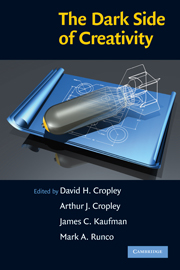Book contents
- Frontmatter
- Contents
- List of Contributors
- 1 The Dark Side of Creativity: What Is It?
- 2 Creativity Has No Dark Side
- 3 Positive Creativity and Negative Creativity (and Unintended Consequences)
- 4 Subjugating the Creative Mind: The Soviet Biological Weapons Program and the Role of the State
- 5 Imagining the Bomb: Robert Oppenheimer, Nuclear Weapons, and the Assimilation of Technological Innovation
- 6 The Innovation Dilemma: Some Risks of Creativity in Strategic Agency
- 7 Early Creativity as a Constraint on Future Achievement
- 8 Boundless Creativity
- 9 Reviewing the Art of Crime: What, If Anything, Do Criminals and Artists/Designers Have in Common?
- 10 Creativity in Confinement
- 11 Creativity and Crime: How Criminals Use Creativity to Succeed
- 12 So You Want to Become a Creative Genius? You Must Be Crazy!
- 13 Both Sides of the Coin? Personality, Deviance, and Creative Behavior
- 14 Neurosis: The Dark Side of Emotional Creativity
- 15 Dangling from a Tassel on the Fabric of Socially Constructed Reality: Reflections on the Creative Writing Process
- 16 Creativity in the Classroom: The Dark Side
- 17 The Dark Side of Creativity and How to Combat It
- 18 A Systems Engineering Approach to Counterterrorism
- 19 Malevolent Innovation: Opposing the Dark Side of Creativity
- 20 Summary – The Dark Side of Creativity: A Differentiated Model
- Index
- References
3 - Positive Creativity and Negative Creativity (and Unintended Consequences)
Published online by Cambridge University Press: 05 June 2012
- Frontmatter
- Contents
- List of Contributors
- 1 The Dark Side of Creativity: What Is It?
- 2 Creativity Has No Dark Side
- 3 Positive Creativity and Negative Creativity (and Unintended Consequences)
- 4 Subjugating the Creative Mind: The Soviet Biological Weapons Program and the Role of the State
- 5 Imagining the Bomb: Robert Oppenheimer, Nuclear Weapons, and the Assimilation of Technological Innovation
- 6 The Innovation Dilemma: Some Risks of Creativity in Strategic Agency
- 7 Early Creativity as a Constraint on Future Achievement
- 8 Boundless Creativity
- 9 Reviewing the Art of Crime: What, If Anything, Do Criminals and Artists/Designers Have in Common?
- 10 Creativity in Confinement
- 11 Creativity and Crime: How Criminals Use Creativity to Succeed
- 12 So You Want to Become a Creative Genius? You Must Be Crazy!
- 13 Both Sides of the Coin? Personality, Deviance, and Creative Behavior
- 14 Neurosis: The Dark Side of Emotional Creativity
- 15 Dangling from a Tassel on the Fabric of Socially Constructed Reality: Reflections on the Creative Writing Process
- 16 Creativity in the Classroom: The Dark Side
- 17 The Dark Side of Creativity and How to Combat It
- 18 A Systems Engineering Approach to Counterterrorism
- 19 Malevolent Innovation: Opposing the Dark Side of Creativity
- 20 Summary – The Dark Side of Creativity: A Differentiated Model
- Index
- References
Summary
THE UTILITY OF DISTINGUISHING POSITIVE AND NEGATIVE CREATIVITY
Creativity is important to the lone soul; to groups large, small, formal, and informal; and to whole societies and cultures (Csikszentmihalyi, 1999). To capitalize on creativity, however, individuals, organizations, and societies need to understand how different types of people will respond, as far as creativity goes, to different conditions and tasks (Amabile, 1996).
Virtually all existing empirical and theoretical work on creativity to this point, however, has either explicitly focused on or implicitly assumed only positive outcomes from creativity (James, Clark, & Cropanzano, 1999; McLaren, 1993, 1999). That is, creativity is seen as the production of beneficial products (concrete or abstract) by novel means. Discussions of creativity tend to assume that it is always socially desirable. Although a few individuals have mentioned the possibility of negative creativity, that side of creativity has received relatively little research or theoretical attention. Creativity can, though, produce results that are damaging or unpleasant to other individuals, to groups, or to society at large.
Both the most widely used definitions of creativity and the full range of real-world instances of it indicate that creativity does not necessarily produce positive effects. Probably the most widely used definition of creativity is the generation of products or problem solutions that are both novel and useful (Amabile, 1996; James et al., 1999; Runco, 1991). Usefulness is subjective; what is useful to me could be either useless or harmful to you.
- Type
- Chapter
- Information
- The Dark Side of Creativity , pp. 33 - 56Publisher: Cambridge University PressPrint publication year: 2010
References
- 33
- Cited by



